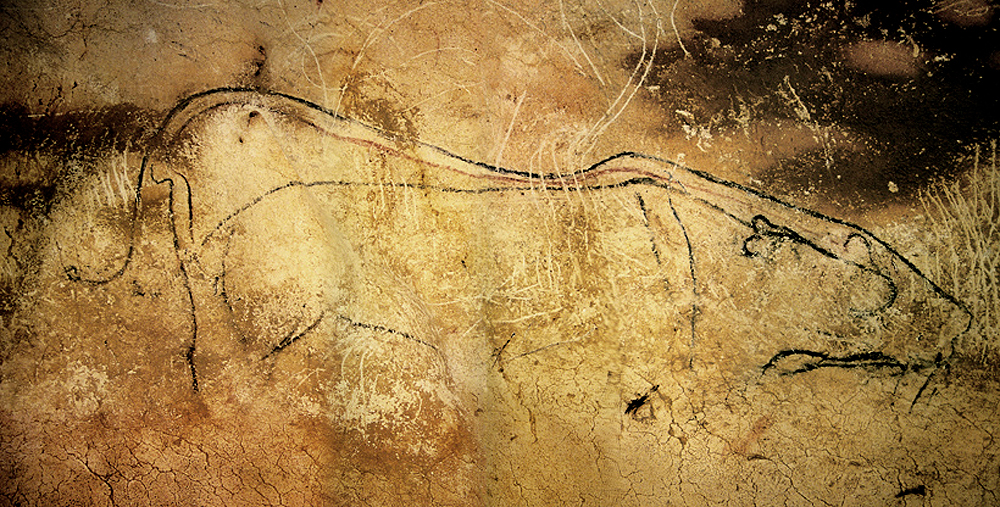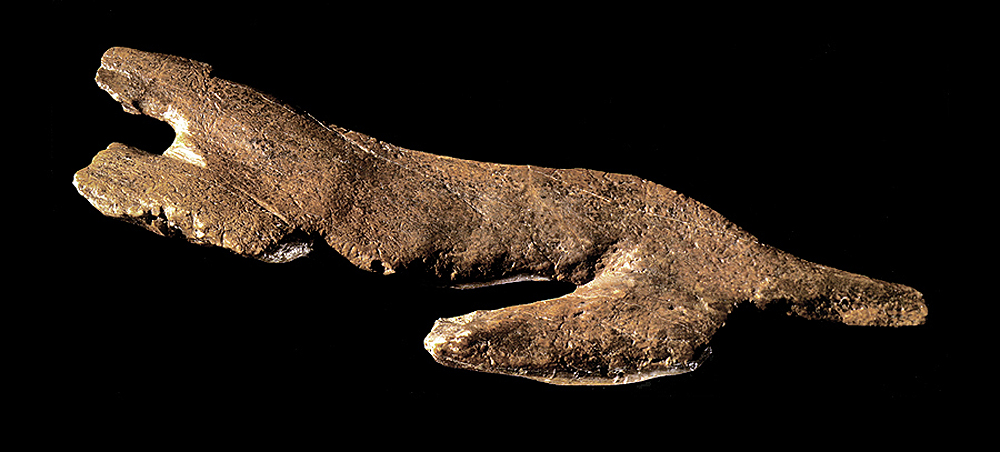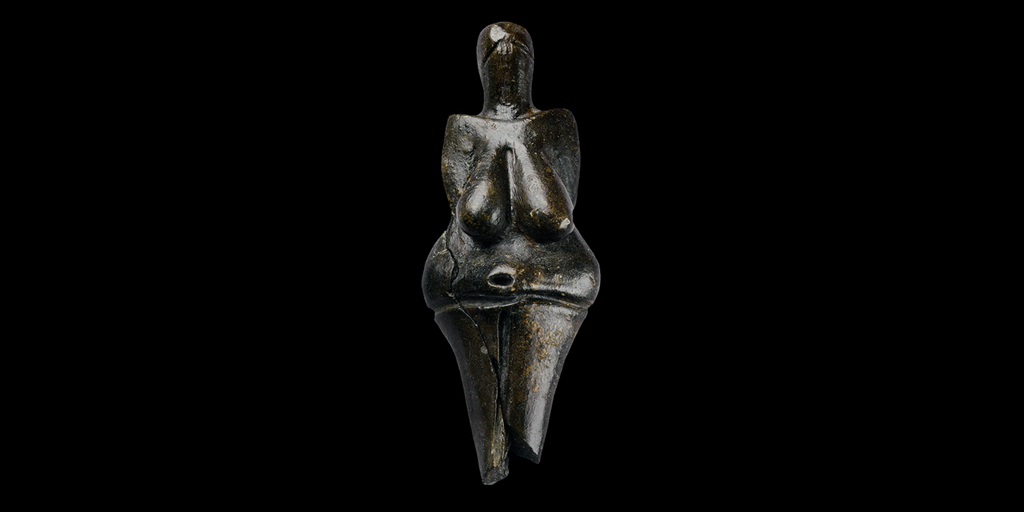


An article provided by the University of York on phys.org - Autism and human evolutionary success - reports on research claiming that a subtle change occurred in our evolutionary history 100,000 years ago which allowed people who thought and behaved differently - such as individuals with autism - to be integrated into society.

Two black lions in the End Chamber of Chauvet
The subtle change occurred with the emergence of collaborative morality. This refers to an investment in the well-being of everyone in the group, and people who displayed autistic traits, for example, would not only have been accepted but possibly respected for their unique skills.

The Leaping Lion of Dolní Věstonice, also known as the Pavlov Lion, carved from mammoth ivory. The sculpture depicts a lion in motion.
The research, published in Time and Mind, suggests it is likely our ancestors would have had autism, with genetics suggesting the condition has a long evolutionary history. Rather than being neglected, these individuals would have played an important role in their social group because of their unique skills and talents.
Human evolution and autism. Clues of autistic traits can be found in cave arthttps://t.co/TWvJLH1tDl #Chauvet #archaeology #evolution pic.twitter.com/r1tXxBI78h
— Bradshaw Foundation (@BradshawFND) November 16, 2016
Penny Spikins, senior lecturer in the archaeology of human origins at the University of York, argues that diversity and variation between people was probably more significant in human evolutionary success than the characteristics of one person. It was diversity between people which led to human success and it is particularly important as it gives you different specialised roles. The rise of collaborative morality led to the possibility for widening the diversity of the human personality.
Many people with autism have exceptional memory skills, heightened perception in realms of vision, taste and smell and enhanced understanding of natural systems such as animal behaviour. The incorporation of some of these skills into a community would play a vital role in the development of specialists.
A previous ethnographic study in 2005 of an elderly reindeer herder from Siberia revealed a detailed memory of the parentage, medical history and character of each one of his 2,600 animals. His vital knowledge would have made a significant contribution to their management and survival. The grandfather was more comfortable in the company of the reindeer than of humans, but was much respected and had a wife and son and grandchildren.

The Woman of Dolní Věstonice. This baked clay female figure is the oldest known ceramic.
Is there tangible evidence of autism in archaeological records? Dr Spikins states that the archaeological record doesn't give us a skeletal record for autism, but what it does do is give us a record for other people who have various differences and how they have been integrated.
One example of this can be found in Upper Palaeolithic cave art and other artefacts. Whilst we can't say some of it was drawn by someone with autism, there are traits that are identifiable to someone who has autism. It was also roughly at that time that we see collaborative morality emerging.
'Are there alternative adaptive strategies to human pro-sociality? The role of collaborative morality in the emergence of personality variation and autistic traits.'
Penny Spikins et al.
Time and Mind (2016). DOI: 10.1080/1751696X.2016.1244949
Abstract
Selection pressures to better understand others' thoughts and feelings are seen as a primary driving force in human cognitive evolution. Yet might the evolution of social cognition be more complex than we assume, with more than one strategy towards social understanding and developing a positive pro-social reputation? Here we argue that social buffering of vulnerabilities through the emergence of collaborative morality will have opened new niches for adaptive cognitive strategies and widened personality variation. Such strategies include those that that do not depend on astute social perception or abilities to think recursively about others' thoughts and feelings. We particularly consider how a perceptual style based on logic and detail, bringing certain enhanced technical and social abilities which compensate for deficits in complex social understanding could be advantageous at low levels in certain ecological and cultural contexts. 'Traits of autism' may have promoted innovation in archaeological material culture during the late Palaeolithic in the context of the mutual interdependence of different social strategies, which in turn contributed to the rise of innovation and large scale social networks.
Editor's Note:
Upper Palaeolithic cave art and portable art certainly display incredible attention to detail. The cave lions in Chauvet are sometimes depicted with a single quintessential line. The sculpture of the Leaping Lion depicting an attack displays a power and energy that could only be achieved by a thorough knowledge of anatomy at a precise moment.
Moreover, there is evidence of task specialization in the Upper Palaeolithic, such as at Dolní Věstonice; people with individual skills were supported by others involved in subsistence activities. One such skill was ceramic production. A dedicated space with a kiln has been identified, where ceramics were produced - not for containers but for figurines. For the figurines, a durable result would have been sought, and analysis shows that the ceramic maker had discovered that by adding powdered bone to the clay, the figure would heat more evenly and not explode or crack in the process. This same alloy created a self-glazing finish, as demonstrated by the Woman from Dolní Věstonice.
The Art of the Chauvet Cave:
http://www.bradshawfoundation.com/chauvet/index.php
The Art of the Ice Age:
http://www.bradshawfoundation.com/sculpture/index.php
Dolní Věstonice and task specialization in the Upper Palaeolithic:
http://www.bradshawfoundation.com/news/archaeology.php?id=Doln---V--stonice
Comment
by Bradshaw Foundation
Tuesday 21 March 2023
by Bradshaw Foundation
Tuesday 07 February 2023
by Bradshaw Foundation
Thursday 19 May 2022
by Bradshaw Foundation
Tuesday 19 October 2021
by Bradshaw Foundation
Friday 25 June 2021
by Bradshaw Foundation
Monday 09 November 2020
by Bradshaw Foundation
Tuesday 03 November 2020
by Bradshaw Foundation
Wednesday 28 October 2020
by Bradshaw Foundation
Tuesday 23 June 2020
by Bradshaw Foundation
Thursday 04 June 2020
by Bradshaw Foundation
Thursday 14 May 2020
by Bradshaw Foundation
Tuesday 12 May 2020
by Bradshaw Foundation
Wednesday 19 February 2020
by Bradshaw Foundation
Tuesday 21 January 2020
by Bradshaw Foundation
Monday 20 January 2020
by Bradshaw Foundation
Thursday 28 November 2019
by Bradshaw Foundation
Tuesday 21 March 2023
by Bradshaw Foundation
Tuesday 07 February 2023
by Bradshaw Foundation
Thursday 19 May 2022
by Bradshaw Foundation
Tuesday 19 October 2021
by Bradshaw Foundation
Friday 25 June 2021
by Bradshaw Foundation
Monday 09 November 2020
by Bradshaw Foundation
Tuesday 03 November 2020
by Bradshaw Foundation
Wednesday 28 October 2020
by Bradshaw Foundation
Tuesday 23 June 2020
by Bradshaw Foundation
Thursday 04 June 2020
by Bradshaw Foundation
Thursday 14 May 2020
by Bradshaw Foundation
Tuesday 12 May 2020
by Bradshaw Foundation
Wednesday 19 February 2020
by Bradshaw Foundation
Tuesday 21 January 2020
by Bradshaw Foundation
Monday 20 January 2020
by Bradshaw Foundation
Thursday 28 November 2019
Friend of the Foundation











